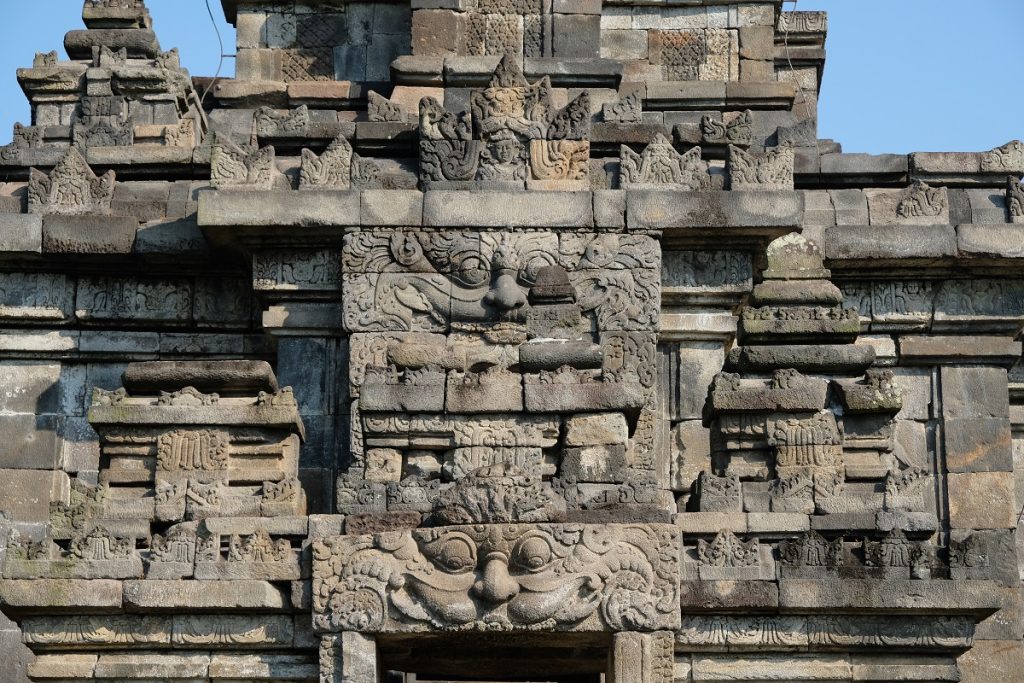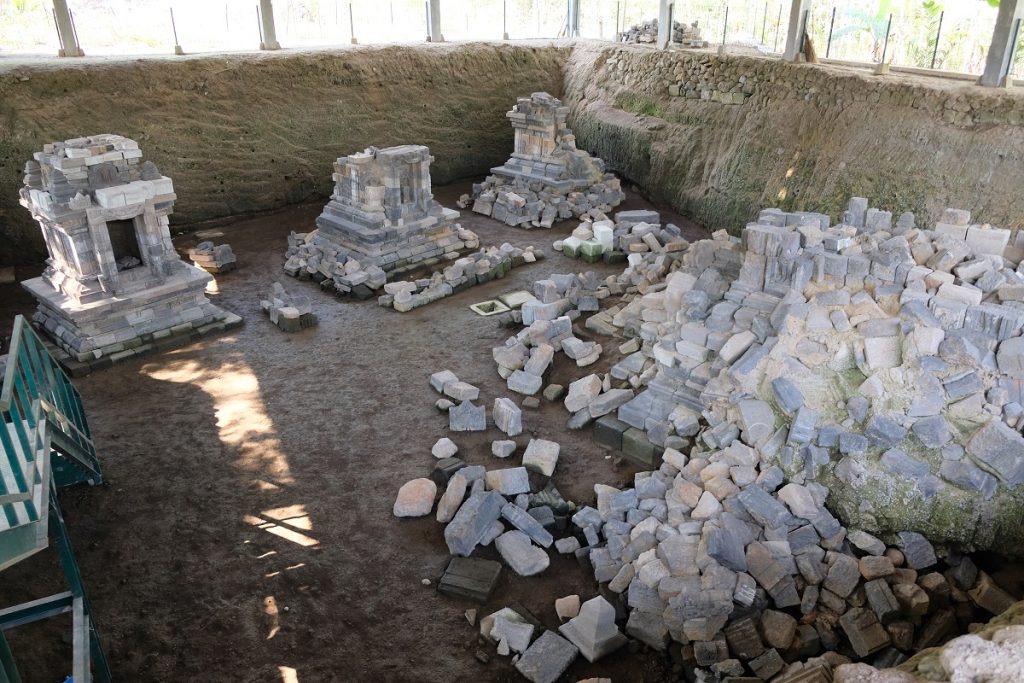A pair of big round eyeballs are staring at mine with a curly mane accentuating the creature’s fierce face. Standing on its hind legs, with mouth agape and chest puffed up above its forelegs, one of the prancing lions of Candi Ngawen stands before me, more than 1,000 years after it was hewn from andesite rock by the hands of a skillful sculptor of Java, at a time when the island’s residents were still predominantly Hindu and Buddhist. It must have taken a concerted effort by a lot of artisans like him to create this beautiful temple, whose current name reflects that of the tranquil Muslim-majority village that later sprang up around its ruins.
Situated on the outskirts of Yogyakarta (also called Jogja), one of three provinces on the island of Java that are home to the majority of Indonesia’s ancient Hindu and Buddhist temples, Candi Ngawen had been on my wish list for almost a decade, thanks to its unique standing lions that adorn the temple’s four corners. However, throughout the years I always ended up exploring ancient temples elsewhere – others that are not too far from the city of Jogja (that I visited during the Spice Odyssey in 2015), those closer to my hometown in Semarang (the temples of Gedong Songo and Ngempon), and the ones in East Java, including the magnificent Candi Penataran, the intriguing temples near Malang (Candi Kidal and Candi Jago, as well as Candi Singhasari), as well as the vestiges of the last major Hindu kingdom on Java (Trowulan), to name some.
On a Saturday morning, one hour after leaving Jogja, we arrived in a village with rice paddies and modest houses laid out in a quiet, bucolic setting. Our driver kept following the main road until we saw a dark structure made of andesite (a type of volcanic rock that was a common building material on the island in the past) rising amid its green surroundings. Except for our driver and the staff members responsible for taking care of the temple compound, we were the only people there, allowing us to take as many photos as we wanted without being judged by others.
At a glance, Candi Ngawen appeared to be a Hindu temple by virtue of its architectural style. Carved on its façades are depictions of kinnaras (half-bird celestial beings in Hindu-Buddhist mythology), deities in Svargaloka (a heavenly realm in Hindu cosmology), as well as Kala-Makara which are often present at the entrance of classical Javanese temples. However, when we peered into the sanctum through the metal bars of its modern door, a headless Buddha statue sat in solitude right in the middle of it. Not long afterward, one of the staff members approached us and asked if we wanted to go inside. What he told us next confirmed my worry about the metal bars; this locked door was installed due to the theft of artifacts in the past with the most recent incident in 1999, a year after the Indonesian economy collapsed following the 1997/98 Asian Financial Crisis. The friendly man returned to his office to get the key, and a few moments later we were already inside, the most sacred part of this temple structure.
Temple 2, where we were standing, is the only structure of the original five that has been reconstructed by the Dutch in the early 20th century. The remaining four, however, lack original stone blocks, leaving their bases the only parts that can be seen today. Nevertheless, without doubt this temple compound must have been quite important in the past given its considerable size. The friendly caretaker had by now returned to his office, leaving the three of us roaming the five ancient structures by ourselves. Once we had taken enough photos, we walked back to the entrance, past piles of stone blocks from the unreconstructed temples. We were ready to return to the city. But upon seeing the same man again, he told us about another temple not too far from where we were which we could visit on our way back.

Temple 2 from another angle

Two Makaras at the base of the stairs of Temple 2

The head of Kala depicted in Central Javanese style

Beautiful stone carvings made by Javanese sculptors more than 1,000 years ago
“It was discovered a few years ago, and until recently people couldn’t reach the temple because it was flooded,” he explained. “But now you can visit it because it’s dry.”
I made sure our driver knew the way, and after thanking the caretaker for the information we were back on the road. It didn’t take long before we turned down another small village road which would supposedly take us to this lesser-known temple. This was an even more quieter village with only a handful of houses. We breezed past rice paddies and fields planted with other crops until all of us noticed a small signboard indicating our destination. The driver pulled over and the three of us got out of the car. But we didn’t see anyone around, not even at the small office near the entrance. We decided to enter and walk down the pathway, flanked on both sides by salak (Salacca zalacca) trees – a species of plant native to Java and Sumatra – toward a shaded enclosure at the end of the path. The ancient temple compound now known as Candi Losari revealed itself only after we arrived at the perimeter fence, and surprisingly, the structures turned out to be larger than what I had expected.
Later I learned that when it was discovered in 2004, buried in thick layers of volcanic ash and soil, the temples were not flooded. It was only in 2013 when the archaeological agency of Central Java excavated the ground around the base of the temples, water started gushing out, eventually inundating the pit to a height of 3 meters. James, Liesha and I followed the small staircase that led to the temples, and once we were down there it felt both surreal and exciting at the same time, for we were standing a few meters below the Earth’s surface. We wandered around this compound of four structures – the largest one is still unreconstructed – and spotted ancient carvings on some parts of the stone blocks. A lintel with a Kala head carved on it and two Makaras close by indicated where the entrance to the sanctum was once located. Another stone clearly bore the sculpted feet of a figure which could have been the main deity worshiped at the temple, or one of the characters associated with that deity.
Then suddenly someone appeared high above us behind the fence guarding the sunken enclosure.
“After you’re done, please fill in the guestbook,” the woman said to us.
We didn’t spend as much time in Candi Losari compared to Candi Ngawen. However, I couldn’t help feeling intrigued and fascinated to know that up to this day more and more ancient Hindu-Buddhist temples are still being rediscovered across Java. Many of them disappeared from collective memory not only as Islam replaced Hinduism and Buddhism as the dominant religion on the island starting from the 15th century, but also because of numerous earthquakes and volcanic eruptions in the past that had damaged and buried many of those structures.
Soon enough, we climbed the stairs back up to ground level and went to the office where the woman was already waiting for us. We were ready to leave after writing our names in the guest book, but the young staff member suddenly told us about another temple not far from Candi Losari.
“It was unearthed very recently. If you want to see it you can follow the road.”
It was very tempting, indeed, since we were ‘in the area’. However, we decided to skip this one and opted to head back to the city after thanking her for telling us about this other site. Maybe next time.
It may take a few years until Candi Losari is completely reconstructed. But there’s a relatively more well-known ancient Hindu temple closer to the city that was once also buried deep in the ground yet now sees the sun again. And what happened to it can give us a clue to Candi Losari’s future.

Candi Losari, a relatively recent discovery

Walking around the ancient structures